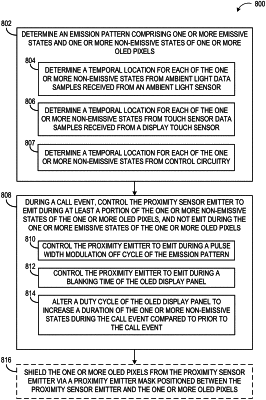| CPC H10K 59/126 (2023.02) [G01S 17/04 (2020.01); G06F 3/041 (2013.01); G09G 3/3233 (2013.01); G09G 2320/0247 (2013.01); G09G 2320/064 (2013.01); G09G 2360/144 (2013.01); G09G 2360/145 (2013.01)] | 20 Claims |

|
1. A display device, comprising:
an OLED display panel;
a proximity sensor having a proximity sensor emitter positioned behind one or more OLED pixels of the OLED display panel with respect to a viewing surface of the OLED display panel; and
a proximity emitter mask positioned between the proximity sensor emitter and the one or more OLED pixels to shield the one or more OLED pixels from the proximity sensor emitter, wherein the display device is configured to,
determine an emission pattern comprising one or more non-emissive states and one or more emissive states of the one or more OLED pixels,
wherein each of the one or more non-emissive states comprises a temporal location determined from touch sensor data samples received from a display touch sensor of the display device, and
during a call event, control the proximity sensor emitter to emit during at least a portion of the one or more non-emissive states of the one or more OLED pixels, and not emit during the one or more emissive states of the one or more OLED pixels.
|